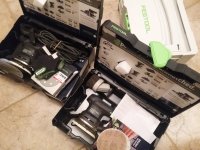ChuckM said:
By the way, if the Pro5 was sold new for $100US by Festool, the starting point was $100 for calculating the discount % in the resell, because that is the price the seller paid for his tool.
That is a pretty rigid way of thinking. So no accounting at all that this original PRO 5 was a very rare limited time offer? A deal where Festool sold it way below it's actual value?
Snip.
-- When I calculate a transactional profit or loss, discounts or otherwise from an accounting point of view, I use historical/book value as the basis. It is not about rigidity or flexibility because once I include other "judgment" factors into my calculations, the math can become way more complex which may require re-valuation, assigning value, etc.
Consider this: If I sold one of my Pro5s brand new, unused, say, at the same original price I paid after owning it for just 1 day, should I consider the sale a breakeven, a loss, or a gain? According to your reasoning, I should celebrate it for a big profit, right? In reality, it wasn't.
Alex said:
So you avoid my question, how much pennies would you save if you had to buy this sander new, same functionality, same quality? That would cost you $200, right? That's a $130 saving, or 13.000 pennies. Would you think 13.000 pennies are a lot of pennies?
I am not quite following your thinking here. The original cost of the Pro5 the owner was selling cost him $100US (?), and he was asking $70. It is not new, nor is it being sold under the same model # or condition of another new sander. When I calculate savings, I look at how much it would have cost me when buying the item new (in 2016) vs how much I would be actually paying now for it. Why would I use a $200 figure, presumably the cost for a different sander under a DIFFERENT model #, when the seller did not pay that amount for his sander in the first place?
Remember this: the same item manufactured by the same source sold by different vendors under different brands could carry significantly different prices (values?) regardless the fact that they may be selling the SAME item. Why would one pick the higher or the highest quote available instead of the actual cost to do any financial analysis?


